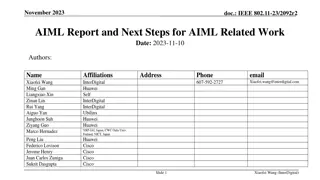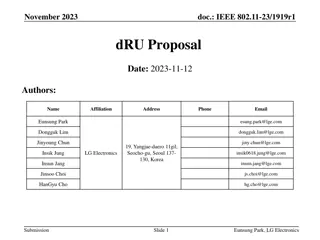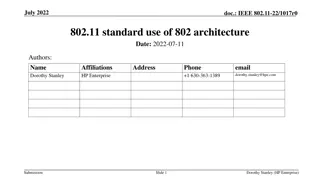IEEE 802.11 Proposal for 320MHz Ranging Enhancement
This document discusses the proposal for enhancing IEEE 802.11 with support for 320MHz bandwidth ranging operations. It aims to improve ranging accuracy by expanding 802.11az frames and procedures to accommodate the increased bandwidth. The focus is on MAC-related changes, exploring different options to indicate 320MHz bandwidth in key frames like Ranging NDPA and Ranging Trigger variants. The proposal also addresses nuances in regions with varying bandwidth capabilities, offering better precision than the existing 160MHz bandwidth. The document outlines specific enhancements and modifications required for successful implementation.
Download Presentation

Please find below an Image/Link to download the presentation.
The content on the website is provided AS IS for your information and personal use only. It may not be sold, licensed, or shared on other websites without obtaining consent from the author. Download presentation by click this link. If you encounter any issues during the download, it is possible that the publisher has removed the file from their server.
E N D
Presentation Transcript
March 2023 doc.: IEEE 802.11-23/0048r3 Follow-up on 320MHz NTB/TB ranging Date: 2023-03-15 Authors: Name Affiliations Address Phone email Yanjun Sun Ali Raissinia Steve Shellhammer Qualcomm George Cherian Christine Zhang Youhan Kim Submission Slide 1 Yanjun Sun, Qualcomm Inc
Jan 2023 doc.: IEEE 802.11-23/0048r3 Introduction Background: 802.11az has been developed over 802.11ax and supports up to 160 MHz bandwidth Motivation: 320 MHz operation has been defined in 802.11be 320 MHz BW can offer better resolution than 160 MHz BW in ranging Objective: Expand appropriate 11az frames and procedures with 320 MHz support Submission Slide 2 Yanjun Sun, Qualcomm Inc
Jan 2023 doc.: IEEE 802.11-23/0048r3 Scope of This Contribution Focus on MAC related changes Explore options to indicate 320 MHz BW in the following frames: Ranging NDPA Ranging Trigger variants IFTMR/IFTM for session negotiation Assumptions: May support some non-OFDMA puncturing patterns (see [1]) Some regions may only have 240 MHz bandwidth Still offers better accuracy than 160 MHz BW Frame exchange sequence are expected to remain the same as in 11az to maximize the reuse of existing logics Submission Slide 3 Yanjun Sun, Qualcomm Inc.
Jan 2023 doc.: IEEE 802.11-23/0048r3 NDPA ENHANCEMENT Submission Slide 4 Yanjun Sun, Qualcomm Inc.
Jan 2023 doc.: IEEE 802.11-23/0048r3 Recap: 11az Ranging NDPA NOTE: AIDs of 2044 and 2045 also have unique formats With secure LTF Submission Slide 5 Yanjun Sun, Qualcomm Inc.
Jan 2023 doc.: IEEE 802.11-23/0048r3 Recap: 320 MHz indication in EHT NDPA For NDPA in non-HT Duplicate PPDU: B7 in the SERVICE field is set to 1 to indicate 320 MHz based on the following 11be spec text: If the CH_BANDWIDTH_IN_NON_HT parameter in the TXVECTOR primitive is present and is equal to CBW320, then bit 7 of the SERVICE field is set to 1. The remaining 8 bits (8 15) of the SERVICE field shall be reserved for future use. For NDPA in EHT MU PPDU: The U-SIG field can indicate 320 MHz Submission Slide 6 Yanjun Sun, Qualcomm Inc.
Jan 2023 doc.: IEEE 802.11-23/0048r3 Proposal #1: 320 MHz for Ranging NDPA Use existing Ranging NDPA variant encoding in 11az and existing 320MHz indication in 11be No change to the Ranging NDPA MAC content non-HT dup PPDU: set B7 in SERVICE field to 1 to indicate 320 MHz EHT MU PPDU: set PHY header to indicate 320 MHz Non-HT Duplicate PPDU PHY preamble Service PSDU Set B7 to 1 as defined in 11be Use the existing Ranging NDPA format defined in 11az EHT MU PPDU or Future PPDU PHY preamble Service PSDU Use the existing Ranging NDPA format defined in 11az Use the Bandwidth field in the U-SIG field to indicate 320 MHz as defined in 11be Submission Slide 7 Yanjun Sun, Qualcomm Inc.
Jan 2023 doc.: IEEE 802.11-23/0048r3 TRIGGER ENHANCEMENT Submission Slide 8 Yanjun Sun, Qualcomm Inc.
Jan 2023 doc.: IEEE 802.11-23/0048r3 Recap: 11az Trigger frame variants Submission Slide 9 Yanjun Sun, Qualcomm Inc.
Jan 2023 doc.: IEEE 802.11-23/0048r3 Recap: 320 MHz indication in EHT Trigger Submission Slide 10 Yanjun Sun, Qualcomm Inc.
Jan 2023 doc.: IEEE 802.11-23/0048r3 Proposal #2: 320 MHz for Ranging Trigger Add the Special User Info field defined in 11be to the Ranging Trigger frame variants defined in 11az, with B54 and B55 set to 0 to solicit 320 MHz EHT TB PPDU Benefit: simple Set B55 to 0 to indicate the presence of the following Special User Info field, which uses the format defined in 11be to indicate 320 MHz Set trigger type subfield to 8 to indicate the Ranging variant Submission Slide 11 Yanjun Sun, Qualcomm Inc.
Jan 2023 doc.: IEEE 802.11-23/0048r3 Proposal #3 Clarification on PPDU Types for Ranging Trigger frame Use-case: a BSS often has a mix of HE STA and EHT STAs Issue: if the TF Ranging Poll frame is sent in EHT PPDU, the TXOP will be wasted if no EHT STA responds, even if some HE STAs want to participate in the ranging sequence. Candidate solution: RSTA should transmit TF Ranging Poll in non-HT duplicate PPDU instead of EHT PPDU to serve both EHT/HE STAs Based on received CTS response, subsequent PPDUs (Ranging sounding, NDPA) may use EHT/HE/non-HT dup PPDUs Submission Slide 12 Yanjun Sun, Qualcomm Inc.
Jan 2023 doc.: IEEE 802.11-23/0048r3 SESSION NEGOTIATION ENHANCEMENTS Submission Slide 13 Yanjun Sun, Qualcomm Inc.
Jan 2023 doc.: IEEE 802.11-23/0048r3 Recap: Negotiation with IFTMR From 11md and 11az: Expansion is needed New subelement(s) for 11be related info Submission Slide 14 Yanjun Sun, Qualcomm Inc.
Jan 2023 doc.: IEEE 802.11-23/0048r3 Recap: Negotiation with IFTM Expansion is needed New subelement(s) for 11be related info Submission Slide 15 Yanjun Sun, Qualcomm Inc.
Jan 2023 doc.: IEEE 802.11-23/0048r3 Proposal #4: Additional Info for IFTMR/IFTM Use the reserved entries in the Format And Bandwidth subfield to indicate 320 MHz Add entries for 320 MHz Candidate entries for 320 MHz Value 6 to indicate EHT (single RF LO) for 320 MHz This value indicates that the STA also supports values of 5, 2, 1 and 0 NOTE: an EHT BSS does not support 80+80 or 160+160 Submission Slide 16 Yanjun Sun, Qualcomm Inc.
Jan 2023 doc.: IEEE 802.11-23/0048r3 Puncturing Pattern Update Issue: if an AP updates its puncturing pattern, how to handle a session that has already been established? For associated STAs: can learn the updated pattern through Beacon For unassociated STAs: cannot learn the change if they don t monitor the Beacons continuously Discussion from Nov meeting: Need a way to adopt the latest puncturing pattern Proposal: FTM parameter modification or session termination is used to avoid using the old puncturing pattern Similar solution can be used for Transmit Power Envelop (TPE) Define a new subelement for puncturing and another for TPE Submission Slide 17 Yanjun Sun, Qualcomm Inc.
Jan 2023 doc.: IEEE 802.11-23/0048r3 Summary This contribution explored options to indicate 320 MHz BW in the following frames by an 11be STA Ranging NDPA Ranging Trigger variants IFTMR/IFTM for session negotiation and re-establishment On EHT/HE BSS Configuration with Puncturing The analysis showed that the indications of 320 MHz defined in 11be can be applied to the above frames from 11az As the 11be indications are outside the fields that carries the 11az-specific info Submission Slide 18 Yanjun Sun, Qualcomm Inc.
Jan 2023 doc.: IEEE 802.11-23/0048r3 Straw Poll #1 Do you agree that the 320 MHz NDP Announcement frame of 802.11bk will use existing Ranging NDP Announcement variant encoding in 802.11az and existing 320MHz indication in 802.11be? No change to the 802.11az Ranging NDP Announcement MAC content For a non-HT dup PPDU: set B7 in SERVICE field to 1 to indicate 320 MHz For an EHT MU PPDU: use the Bandwidth field in the U-SIG field to indicate 320 MHz Yes: 16 No: 0 Abstain: 1 Submission Slide 19 Yanjun Sun, Qualcomm Inc.
Jan 2023 doc.: IEEE 802.11-23/0048r3 Straw Poll #2 Do you agree that a 320 MHz Ranging Trigger frame in 802.11bk sets the Trigger Type subfield in the Common Info field to 8 as in 802.11az and includes the Special User Info field immediately after the Common Info field as defined in 802.11be? Yes: 14 No: 0 Abstain: 2 Submission Slide 20 Yanjun Sun, Qualcomm Inc.
March 2023 doc.: IEEE 802.11-23/0048r3 Straw Poll #3 (updated in r3) Do you agree that IFTMR/IFTM frames of 802.11bk will use only a single reserved entry in the Format And Bandwidth subfield to indicate 320 MHz? The entry is for 320 MHz with a single RF LO; If the entry is included in an IFTRM or IFTM frame, it indicates that the transmitter of the frame supports 320 MHz with a single RF LO, 160 MHz with a single RF LO, 80 MHz, 40 MHz and 20 MH.. Yes: No: Abstain: Submission Slide 21 Yanjun Sun, Qualcomm Inc.
Jan 2023 doc.: IEEE 802.11-23/0048r3 Straw Poll #4 Do you agree that IFTMR/IFTM frames of 802.11bk will use a reserved subelement to indicate information on transmit power envelop of the BSS for 320 MHz? Yes: 9 No: 0 Abstain: 14 Submission Slide 22 Yanjun Sun, Qualcomm Inc.
Jan 2023 doc.: IEEE 802.11-23/0048r3 Straw Poll #5 (run out of time, tele call) Do you agree that 802.11bk will extend IFTMR and IFTM frames to indicate puncturing pattern of the BSS in the Ranging Parameters field? Yes No Abstain Submission Slide 23 Yanjun Sun, Qualcomm Inc.
Jan 2023 doc.: IEEE 802.11-23/0048r3 References [1] Thoughts on 320 MHz Ranging NDP, 22/1981r0, https://mentor.ieee.org/802.11/dcn/22/11-22-1981-00-00az-thoughts- on-320-mhz-ranging-ndp.pptx, Steve Shellhammer et al. Submission Slide 24 Yanjun Sun, Qualcomm Inc.
Nov 2022 doc.: IEEE 802.11-23/0048r3 BACKUP Submission Slide 25 Yanjun Sun, Qualcomm Inc.
Nov 2022 doc.: IEEE 802.11-23/0048r3 On 320 MHz-1 and 320 MHz-2 36.3.24.2 Channelization for 320 MHz channel The 320 MHz channel consists of any two adjacent 160 MHz channels in the 6 GHz band. Two type of channelizations for 320 MHz channel are defined: 320 MHz-1 and 320 MHz-2. 320 MHz-1 is defined as 320 MHz channel with channel center frequency numbered 31, 95, and 159. 320 MHz-2 is defined as 320 MHz channel with channel center frequency numbered 63, 127, and 191. Credit: source of the image Submission Slide 26 Yanjun Sun, Qualcomm Inc.























